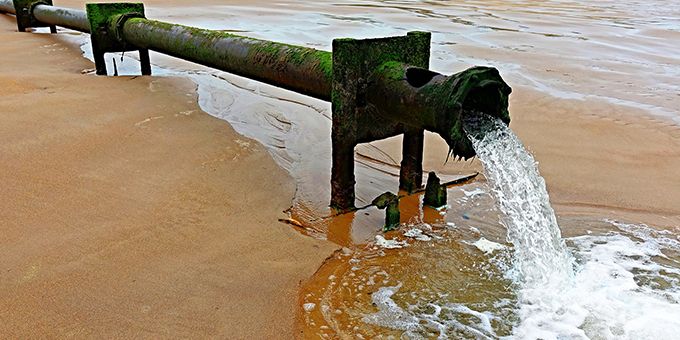The gap between the demand for clean water and the world’s supply of it will only widen in the coming decades. Wildly inconsistent access to potable water sources is one major challenge in the world today when it comes to hydration.
 Here’s How Renewable Energy Benefits the Wastewater Industry
Here’s How Renewable Energy Benefits the Wastewater Industry

Megan Ray Nichols | Schooled by Science
The gap between the demand for clean water and the world’s supply of it will only widen in the coming decades. Wildly inconsistent access to potable water sources is one major challenge in the world today when it comes to hydration.
Another significant hurdle to overcome is the amount of electricity required to desalinate, disinfect and ultimately make wastewater usable for drinking, bathing, watering crops and much more. The coming of age of renewable energy is looking like a considerable advantage here. Technologies like solar, wind, geothermal and others are already helping to bring clean water to more people across the world.
Renewable Energy Improves Water Transportation
Treating and repurposing industrial and municipal wastewater supports processes in a variety of other industries.
One example is sewage sludge. When treated properly, this sludge can be involved in agricultural, mining, horticultural and other processes. This symbiotic relationship is beneficial and eco-friendly. The oil and gas industry is another example. This sector is a leading user of water and producer of wastewater. Hydraulic fracking and other industrial processes yield water that is heavy with dissolved compounds, including salts and silicas.
This wastewater is an untapped resource. The challenge arises with transporting wastewater to treatment facilities, then bringing treated water and sewage sludge, in turn, to wherever it’s useful. These are energy- and infrastructure-intensive processes. Because of this, it’s becoming common to use wind turbines to pump water wherever it’s needed, including to irrigate crops and water livestock.
A turbine eight feet in diameter can pump 150 gallons of water every hour in moderate winds, meaning areas with limited mechanization can receive supplies of water or treated biosolids from nearby treatment plants without vehicles or more complex infrastructure. As electric and autonomous trucks continue to achieve developmental milestones, they’ll play a role in the transportation of water.
Wastewater Treatment Plants Can Generate Renewable Energy
The best thing about renewable energy is that, in many cases, sites that generate and consume clean energy also produce a surplus of energy. Grid-tied solar installations, for example, sometimes net a modest passive income for property owners, in addition to meeting their energy needs.
The same goes for wastewater treatment facilities, even if the concept looks a little different. Sewage is replete with microorganisms providing anaerobic digestive action. The process of breaking down organic matter can generate biogas right onsite.
Harnessing the wastewater treatment process itself to create biogas is an ingenious way to take a bite out of the facility’s energy budget. According to studies, biogas from anaerobic digestion can provide around half the energy required for a treatment plant to function. However, improvements in fuel cell technology and adding sludge pre-treatments can further boost the yield.
Renewable Energy Puts Wastewater Treatment on the Smart Grid
Treating municipal wastewater consumes around 4% of all the energy used in the United States. Moreover, electricity is typically 40% or more of the operating budget for a treatment plant. That leads to two major challenges in the wastewater industry: the cost of maintaining operations and the degree to which treatment facilities depend on a steady supply of energy from utility companies.
The now almost universally acknowledged effects of climate change further compound these challenges. Resilience in the face of natural disasters and the pursuit of more affordable and more sustainable municipal services spurred two towns to invest in renewable energy products.
Caldwell, N.J., and Lee County, Ga., developed plans to add solar arrays and solar storage systems to their facilities. When greenlighting the projects, city leaders cited events like Superstorm Sandy, which knocked out electricity over widespread areas and prevented treatment plants from functioning at all. With renewable energy retrofits, the plants can operate for up to 10 days without outside power. Even better, the influx of clean solar energy will slash their operating budgets by around 57%.
In this way, wastewater treatment plants also become full participants in smart energy grids. Each “node” in a smart grid that generates renewable power can receive or provide energy as demand dictates. Smart grids also make electricity delivery areas more resilient against intense weather events and help utilities isolate and repair problems more quickly than before. As an added bonus, solar power is also instrumental in solar irradiation — a water treatment method that eliminates a wide selection of chemicals and microorganisms, all without harmful byproducts.
Why Is Renewable Energy So Crucial in Wastewater Processing?
The U.N. recognized access to safe drinking water as a human right in 2010. Tragically, the U.N. also reports that as many as 2 billion people live with compromised access to sources of fresh, clean water. In Asia and Africa, studies show that the poorest fifth of the population spends up to 11% of their income on water.
“Bringing costs down” and “using resources more efficiently” are rallying cries all over the world. In some parts of the world, finding the right technologies and techniques could change thousands, perhaps millions, of lives practically overnight.
Renewable energy is a sea change by itself, but when combined with the processes that keep us hydrated and clean, the benefits are extraordinary. From lower utility prices in suburbia to efficient and scalable water infrastructure in even the most impoverished villages and towns, clean energy has positive implications for all.
If you like this article you may like "How Machine Learning Could Impact the Future of Renewable Energy"
The content & opinions in this article are the author’s and do not necessarily represent the views of AltEnergyMag
Comments (0)
This post does not have any comments. Be the first to leave a comment below.
Featured Product

